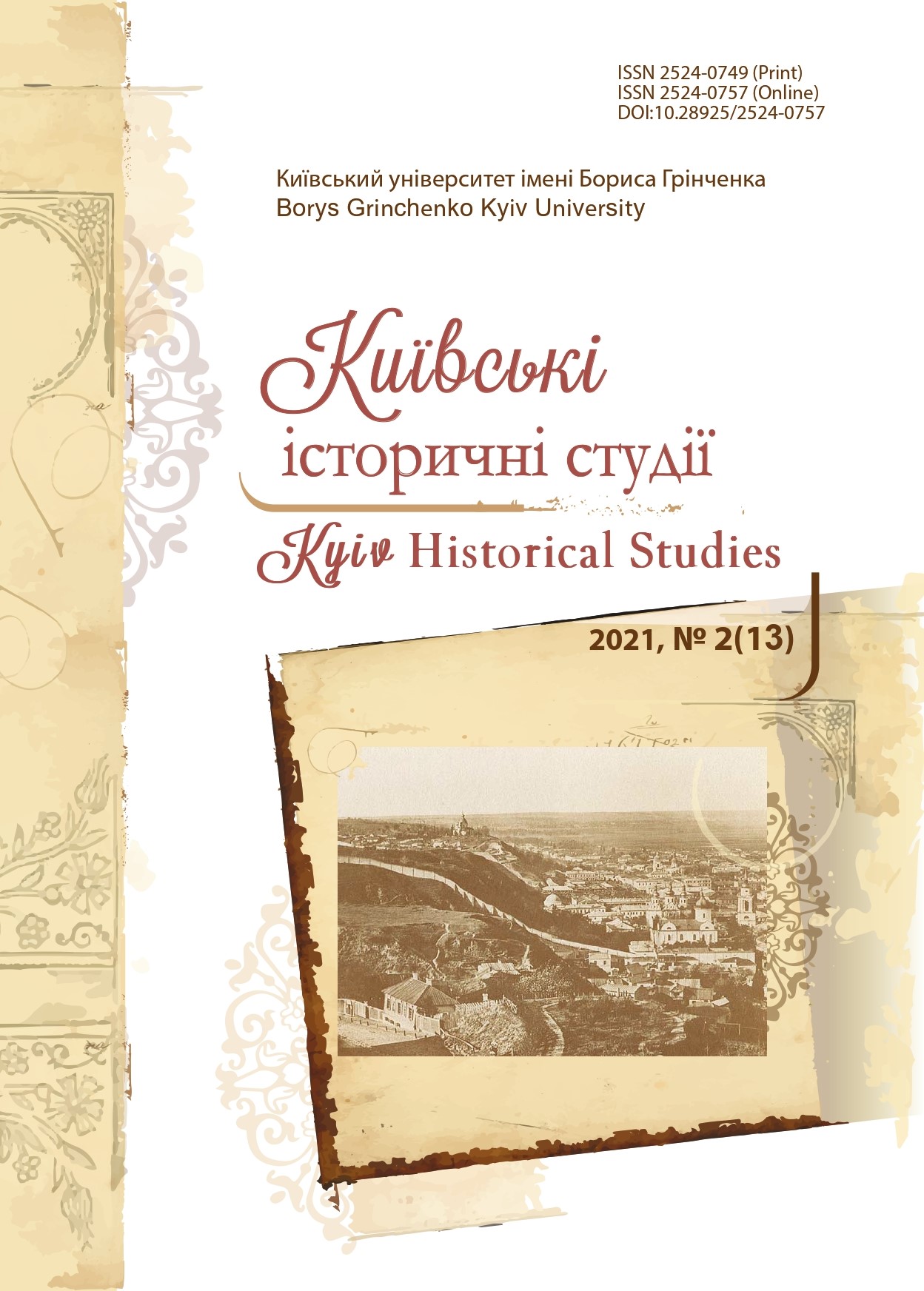Student Apartments: from the History of Everyday Students Life of Yelisavetgrad Six-Class Pprogymnasium in the 80s of the 19th Century
DOI:
https://doi.org/10.28925/2524-0757.2021.214Keywords:
Yelisavetgrad six-class progymnasium, educational institutionsAbstract
The aim of this article is to explore the main aspects of Yelisavetgrad six-class progymnasium management, related to the opening of student apartments, living arrangements and supervision of the students living in those apartments; to analyse the rules that regulated the living conditions of progymnasium students in the mentioned apartments and apartments of relatives. The research methodology is based on a combination of general scientific (analysis, synthesis, generalization) and special-historical (historical-typological, historical-systemic, historical-genetic) methods. The study is based on the principles of historicism, systematicity and scientificity. Based on archival documents, the mechanisms, features and practice of student apartments opening for the students of Yelisavetgrad men’s progymnasium are studied for the first time, which presents the scientific novelty. The forms of control over the personal space of the students by the teaching staff of the progymnasium and the students’ reaction to the established rules are clarified. Analysis of the sources showed that during the 1980s the issue of resettlement of non-resident students was extremely important for Yelisavetgrad educational institutions. In the absence of boarding houses, the increase in the number of students prompted the management of educational institutions to develop rules governing the opening of student apartments, regulating the living conditions of the students and forms of control by the institution over compliance with the rules of both tenants and students. The analysis of the protocols of Yelisavetgrad men’s six-class progymnasium pedagogical council shows that the educational institution treated the opening of student apartments and supervising the living conditions of the students very responsibly: sanitary and hygienic conditions, as well as opportunities to conduct educational activities qualitatively, were taken into account. The control over the observance of the rules was systemic. Probably, this decisively contributed to the fact that among the progymnasium students there was a galaxy of outstanding figures of culture and science. On the other hand, the recollections of former progymnasium students contain facts of intrusion into personal space, which made students feel discomfort associated with strict regulation of living conditions. The study of the pedagogical council meeting protocols makes it possible to trace the fate of the students who due to the difficult financial situation of their families could not pay for accommodation in student apartments allowed by the progymnasium management, so they lost the right to complete education and get the chance for a better life.
Downloads
References
Hromovyi, V. (vidp. red.). (1997). Yelysavethradska himnaziia. Kirovohrad: Ukrainska himnaziia [in Ukrainian].
Pashutin, A. N. (Uporyadn.) (1897). Istoricheskii ocherk g. Yelisavetgrada [Historical Sketch of Yelisavetgrad]. Yelisavetgrad: Lito-tipografiia Br. Shpolianskikh.i [in Russian].
Pylypenko, V. V. (2019). Daily Life of Ukrainian High School Students in the 30–50s of the 19th century. Naukovyi chasopys NPU imeni M. P. Drahomanova, Vypuskk 71, Seriia 5, 183–188 [in Ukrainian]. DOI: https://doi.org/10.31392/NPU-nc.series5.2019.71.42
Ryha, D. (2014). Do istorii stvorennia ta diialnosti navchalnoho zakladu — Chernihivskoi klasychnoi cholovichoi himnazii u 1805–1919 rokakh ta istorii budivel kolyshnioi himnazii u XX stolitti [To the History of Foundation and Activity of the Educational Institution — Chernihiv Classical Men Gymnasium
in 1805–1919 and the History of the Buildings of the Former Gymnasium in the 20th century. Siverianskyi litopys, 4 (118), 241–248 [in Ukrainian].
Ryha, D. (2019). Navchalni prohramy ta predmety, yaki vykladalysia v Chernihivskii klasychnii cholovichii himnazii u XIX stolitti [Curricula and Subjects Taught at the Chernihiv Classical Gymnasium in the 19th Century]. Siverianskyi litopys, 3 (147), 153–161 [in Ukrainian]. DOI: https://doi.org/10.5281/zenodo.3367492
Syrtsova, O. M. (2019). Klasychna serednia osvita u Zaporizhzhi na rubezhi XIX–XX st. ta pochatku XXI st.: porivnialnyi analiz [Classical Secondary Education in Zaporizhzhia at the turn of 19–20 centuries and at the beginning of the 21st century: a comparative analysis. Naukovi pratsi istorychnoho fakultetu Zaporizkoho natsionalnoho universytetu, Vyp. 52, Tom 2, 135‑143 [in Ukrainian]. DOI: https://doi.org/10.26661/swfh-2019-52-047
Stepanova, O. (2019). Shkola heniiv u Yelysavethradi: Istoriia «Domu ofitseriv». [in Ukrainian]. https://dozor.kr.ua/post/shkola-geniiv-u-elisavetgradi-istoriya-domu-ofitseriv-foto-4037.html
Shevchenko, S. I. (2007). Stari stiny: Yelysavethradska hromadska zhinocha himnaziia, 1860 — 1920 rr. Kirovohrad: RVV KDPU imeni Volodymyra Vynnychenka [in Ukrainian].
Published
How to Cite
Issue
Section
License
Copyright (c) 2021 Інна Позднякова

This work is licensed under a Creative Commons Attribution-NonCommercial-ShareAlike 4.0 International License.
Authors who publish in this journal retain the right of authorship of the work and give to the journal right of first publication of this work under the conditions of Creative Commons: Attribution-NonCommercial-ShareAlike 4.0 International (CC BY-NC-SA 4.0), which allows others freely distribute the work published with reference to the authors of the original work and the first publication of this magazine.














